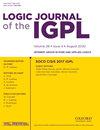利用 1D-CNN 从 K2 数据中探测凌日系外行星并相位折叠其主恒星的光变曲线
IF 0.8
4区 数学
Q2 LOGIC
引用次数: 0
摘要
在这项研究中,我们提出了两个一维卷积神经网络(CNN)模型,并使用模拟光曲线对其进行了训练、验证和测试,模拟光曲线的设计模仿了开普勒太空望远镜在其扩展任务(K2)期间的预期光曲线。我们还在真实的 K2 数据上对其进行了测试。我们的光曲线模拟器考虑了不同的恒星变异现象,如自转、脉动和耀斑,这些现象与 K2 数据中预期的恒星噪声一起,阻碍了凌日信号的探测,就像在真实数据中一样。第一个模型能有效识别光曲线中的凌星信号,并根据是否存在此类信号对光曲线进行分类。此外,第二个模型不仅能对光变曲线进行相位折叠,还能消除恒星噪声,这是将凌日拟合为曼德尔和阿戈尔理论凌日形状的关键步骤。所获得的结果包括:根据是否存在凌星信号对光变曲线进行分类的准确率为 99%;在对光变曲线进行相位折叠时,凌星深度和持续时间的准确率为 6%,这表明 1D-CNN 在光变曲线的凌星搜索自动化方面具有强大的能力,无论是在模拟数据还是真实数据上都是如此。本文章由计算机程序翻译,如有差异,请以英文原文为准。
Detection of transiting exoplanets and phase-folding their host star’s light curves from K2 data with 1D-CNN
In this research, we present two 1D Convolutional Neural Network (CNN) models that were trained, validated and tested using simulated light curves designed to mimic those expected from the Kepler Space Telescope during its extended mission (K2). We also tested them on real K2 data. Our light curve simulator considers different stellar variability phenomena, such as rotations, pulsations and flares, which along with the stellar noise expected for K2 data, hinders the transit signal detection, as in real data. The first model effectively identifies transit-like signals in light curves, classifying them based on the presence or absence of such signals. Furthermore, the second model not only phase-folds the light curves but also eliminates stellar noise, a crucial step when fitting transits to the Mandel and Agol theoretical transit shape. The obtained results include an accuracy of $\sim 99\%$ when classifying the light curves based on the presence or absence of transit-like signals, and $MAPE\sim 6\%$ regarding to the transits’ depth and duration when phase folding the light curves, showing the great capabilities of 1D-CNN for automatizing the transit search in light curves, both on simulated and real data.
求助全文
通过发布文献求助,成功后即可免费获取论文全文。
去求助
来源期刊
CiteScore
2.60
自引率
10.00%
发文量
76
审稿时长
6-12 weeks
期刊介绍:
Logic Journal of the IGPL publishes papers in all areas of pure and applied logic, including pure logical systems, proof theory, model theory, recursion theory, type theory, nonclassical logics, nonmonotonic logic, numerical and uncertainty reasoning, logic and AI, foundations of logic programming, logic and computation, logic and language, and logic engineering.
Logic Journal of the IGPL is published under licence from Professor Dov Gabbay as owner of the journal.

 求助内容:
求助内容: 应助结果提醒方式:
应助结果提醒方式:


